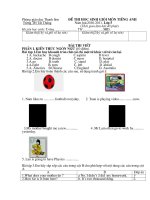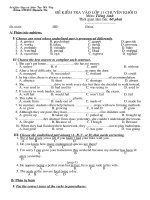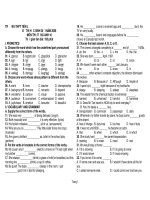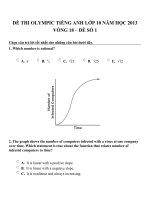Download Đề thi HSG Tiếng anh lớp 10 chuyên
Bạn đang xem bản rút gọn của tài liệu. Xem và tải ngay bản đầy đủ của tài liệu tại đây (160.57 KB, 8 trang )
<span class='text_page_counter'>(1)</span><div class='page_container' data-page=1>
<b>ONTHIONLINE.NET</b>
<b>THPT Chuyên Bắc Ninh</b>
MÔN THI: Anh
KHỐI 10
<b>Nội dung</b>
<b>A. PHONETICS (10p)</b>
<i><b>Question 1: Pick out the word whose underlined part is pronounced differently from those of the other</b></i>
<i><b>words. Write your answers in the numbered blanks provided below (5p)</b></i>
1. A. random B. canal C. many D. explanatory
2. A. good B. moon C. food D. balloon
3. A. provide B. product C. production D. procedure
4. A. kite B. bite C. Christian D. Christ
5. A. voltage B. voyage C. massage D. dosage
Answers:
<i>1.</i> <i>2.</i> <i>3.</i> <i>4.</i> <i>5.</i>
<i><b>Question 2: Choose the word whose stress pattern is differently from those of the other words.</b><b> Write</b></i>
<i><b>your answers in the numbered blanks provided below (5p)</b></i>
1. A. argumentative B. psychological
C. contributory D. hypersensitive
2. A. atomic B. brilliant
C. determined D. ambitious
3. A. trigonometry B. explanatory
C. immediately D. democracy
4. A. photograph B. payroll
C. accent D. regretful
5. A. majority B. ceremony
C. astronomy D. investiture
<b>B. GRAMMAR & VOCABULARY (20p)</b>
<i><b>Question 3: Give the correct tense/ form of the verbs in the brackets. Write your answers in the</b></i>
<i><b>numbered blanks provided below (10p)</b></i>
1. It’s time we (<b>go)</b>. If we (<b>not leave</b>) now, we (<b>miss</b>) the train.
2. I know I (<b>not write</b>) to you before, but I (<b>be</b>) so busy recently that I (<b>not have</b>) time for writing letters.
I (<b>telephone</b>) you instead, but I <b>(forget</b>) your number.
3. Why didn’t you tell me you could lend me the money? I (<b>not borrow</b>) it from the bank.
4. He is walking (<b>hurry</b>) to the place where his ex-wife, a famous naturalist now (<b>lie)</b> (<b>bury</b>) among the
animals she (<b>love</b>) so much.
5. We will see Alice at the corner, she (<b>wait)</b> for us when we (<b>arrive</b>).
6. He resents (<b>be</b>) (<b>tell</b>) what (<b>do</b>).
<b>7</b>. Her mother <b>(go</b>) abroad last month, so it (<b>not be</b>) her you see at the theater last Sunday.
Question 4: The passage below contains 10 errors. IDENTIFY and CORRECT them. (0) has been done as an
example. Write your answers in the numbered blanks below (5p)
</div>
<span class='text_page_counter'>(2)</span><div class='page_container' data-page=2>
the face of the building, and in front, there was a well-kept lawn where previous there had been untidy
gravel yard.
<i><b>Answers: 0. in of</b></i>
<i><b>1. ...</b></i>
<i><b>-->...</b></i>
<i><b>2. ...</b></i>
<i><b>--> ...</b></i>
<i><b>3. ...</b></i>
<i><b>--> ...</b></i>
<i><b>4. ...</b></i>
<i><b>-->...</b></i>
<i><b>5. ...</b></i>
<i><b>--> ...</b></i>
<i><b>6. ...</b></i>
<i><b>-->...</b></i>
<i><b>7. ...</b></i>
<i><b>-->...</b></i>
<i><b>8. ...</b></i>
<i><b>-->...</b></i>
<i><b>9. ...</b></i>
<i><b>-->...</b></i>
<i><b>10. ...</b></i>
<i><b>-->...</b></i>
<i><b>Question 5: Fill in each blank with a suitable PREPOSITION or PARTICLE. Write your answers in</b></i>
<i><b>the numbered blanks provided below the passage. (5p)</b></i>
1. We’re all very obliged ……… you
2. When the wound has healed ... you can remove the plaster.
3. Without a fridge, fresh food will go ... very quickly.
4. I’m faithful ……… my principle.
5. I haven’t heard ... Mandy since she wrote in July.
6. This service is free ……… charge.
7. They went ahead contrary ……… my advice.
8. The weather was fine, and everyone was making ... .. the coast.
9.We’re going ... Tom’s car tomorrow.
10. Have a card...your sleeve.
<b>C. READING (20p)</b>
Question 6: Read the following passage and choose the best answer. Write your answers in the numbered blanks
provided below the passage. (10p)
In addition to the great ridges and volcanic chains, the oceans <b>conceal </b>another form of undersea
mountains: the strange guyot, or flat-topped seamount. No marine geologist even suspected the
existence of these isolated mountains until they were discovered by geologist Harry H. Hess in 1946.
He was serving at the time as naval officer on a ship equipped with a fathometer. Hess named these
truncated peaks for the nineteenth-century Swiss-born geologist Arnold Guyot, who had served on the
faculty of Princeton University for thirty years. Since then, hundreds of guyots have been discovered in
every ocean but the Arctic. Like offshore canyons, guyots present a challenge to oceanographic theory.
They are believed to be extinct volcanoes.Their flat tops indicate that they once stood above or just
below the surface, where the action of waves leveled off their peaks. Yet today, by definition, their
summits are at least 600 feet below the surface, and some are as deep as 8,200 feet. Most lie between
3,200 feet and 6,500 feet. Their tops are not really flat but slope upward to a low pinnacle at the center.
Dredging from the tops of guyots has recovered basalt and coral <b>rubble, </b>and that would be expected
from the eroded tops of what were once islands. Some of this material is over 80 million years old.
Geologists think the drowning of the guyots involved two processes: The great weight of the volcanic
mountains depressed the sea floor beneath them, and the level of the sea rose a number of times,
especially when the last Ice Age ended, some 8,000 to 11.000 years ago.
<i>1. What is the author's main purpose in writing this passage? </i>
A. To trace the career of Arnold Guyot.
B. To describe feature of the undersea world.
C. To present the results of recent geologic research.
D. To discuss underwater ridges and volcano chains
<i>2. The word “<b>conceal”</b> is closest in meaning to which of the following? </i>
A. Contain B. Erode C. Hide D. Create
</div>
<span class='text_page_counter'>(3)</span><div class='page_container' data-page=3>
A. a fathometer B. computer analysic
C. a deep-sea diving expedition D. research submarines
<i>4. The author indicates that Arnold Guyot </i>
A. was Harry Hess's instructor B. invented the fathometer
C. named the guyed after himself D. taught at Princeton University
<i>5. What does the passage sav about the Arctic Ocean? </i>
A. The first guyot was discovered there.
B. No guyots have ever been found there.
C. There are more guyots there than in any other ocean.
D. It is impossible that guyots were ever formed there.
<i>6. The author states that offshore canyons and guyots have which of the following characteristics in</i>
<i>common?</i>
A. Both are found on the ocean floor near continental shelves.
B. Both present oceanographers with a mystery.
C. Both were formed by volcanic activity.
D. Both were, at one time, above the surface of the sea.
<i>7. According to the passage, most guyots are found at a depth of ...</i>
A. less than 600 feet. B. between 600 and 3,200 feet.
C. between 3,200 and 6,500 feet D. more than 8,200 feet
<i>8. Which of the following is closest in meaning to the word “<b>rubble”? </b></i>
A. Fragments B. Mixture C. Columns D. Core
<i>9. According to the passage, which of the following two processes were involved in the submersion of</i>
<i>guyots?</i>
A. Erosion and volcanic activity.
B. The sinking of the sea floor and the rising of sea level.
C. Mountain building and the action of ocean currents
D. High tides and earthquakes
<i>10. According to the passage, when did sea level significantly rise?</i>
A. In 1946 B. In the nineteenth century
C. From 8,000 to 11,000 years D. 80 million years ago
<i><b>Question 7: Read the following passage and choose the best answer. Write your answers in the</b></i>
<i><b>numbered blanks provided below the passage. (10p) </b></i>
As Christmas evolved in the United States, new customs were adopted and many old ones were
reworked. The legend of Santa Claus, for example, had origins in Europe and was brought by Dutch
settlers to New York in the early 18th<sub> century. Traditionally, Santa Claus from the Dutch Sinter Klaas </sub>
-was depicted as a tall, dignified, religious figure riding a white horse through the air. Known as Saint
Nicholas in Germany, he was usually accompanied by Black Peter, an elf who punished disobedient
children. In North America he eventually developed into a fat, jolly old gentleman who had neither the
religious attributes of Saint Nicholas nor the strict disciplinarian character of Black Peter.
Santa’s transformation began in 1823, when a New York newspaper published the poem A Visit
<i>from Saint Nicholas, which Clement Clark Moore had written to amuse his daughter. The poem</i>
introduced many Americans to the story of a kindly saint who flew over housetops in a reindeer-drawn
sleigh. Portraits and drawings of Santa Claus by American illustrator Thomas Nast further strengthened
the legend during the second half of the 19th<sub> century. Living at the North Pole and assisted by elves, the</sub>
modern Santa produced and delivered toys to all good children. By the late 19th<sub> century he had become</sub>
</div>
<span class='text_page_counter'>(4)</span><div class='page_container' data-page=4>
<i><b>1.</b><b>Who brought the legend of Santa Claus to the USA according to the passage?</b></i>
A. Sinter Klaas B. Saint Nicholas
C. A German D. Dutch settlers
2. Santa Claus was traditionally described as a ...
A. tall man who could walk through the air.
B. fat, jolly, old man.
C. religious figure.
D. fat man riding a white horse.
<i>3. Santa Claus in North America was depicted as ...</i>
A. a man with the strict disciplinarian character of Black Peter.
B. a good old man with less religious character.
C. one with religious attributes of Saint Nicholas.
D. a jolly man on horseback.
4. Who was Black Peter?
A. an elf accompanying Saint Nicholas.
C. one of the disobedient children.
B. an elf who rode a white horse.
D. a popular traditional figure.
<i>5. What word is closest in meaning to “attributes”?</i>
A. symbols of a person
B. natural qualities C. effects D. outer appearance
6. Where did the legend of Santa Claus come from?
A. the North Pole B. Europe
C. North America D. the City of New York
7. 1823 was mentioned as a year when ...
A. Clement Clark Moore wrote his first poem.
B. Clement Clark Moore’s poem made him popular.
C. Saint Nicholas visited New York.
D. the image of Santa Claus was transformed.
<i>8. According to Clement Clark Moore’s poem,</i>
A. Santa Claus had nothing different in appearance from the traditional one.
B. Santa Claus had wings and could fly.
C. Santa Claus liked poetry.
D. Santa Claus was a kindly saint who flew over housetops in a sleigh.
9. The answer “Yes, Virginia, there is a Santa Claus” is an illustration for the fact that...
A. the New York Sun was popular with children.
B. Santa Claus was a prominent figure at that time.
C. newspapers are unreliable.
D. Virginia O’Hanlon was a reader of the New York Sun.
<i>10. Which of the following statements is TRUE?</i>
A.Santa Claus was an imaginary old man created by artists based on traditional figures.
B. Living in the North Pole, Santa Claus visited children at Christmas.
C. Santa Claus was a real figure living in northern America.
D. Santa Claus was a story based on Saint Nicholas and Black Peter.
<i><b>D. USE OF ENGLISH (20p)</b></i>
<i><b>Question 8: Choose the word that best fits each of the blanks in the following passage. Write your</b></i>
<i><b>answers in the numbered blanks provided below the passage. (0) has been done as an example. (5p)</b></i>
</div>
<span class='text_page_counter'>(5)</span><div class='page_container' data-page=5>
does a (1) _____ bow of the head. In rural areas, elderly people do not extend their hand are greeted with
a bow. Women are more (2) _____ to bow the head than to shake hands. Vietnamese names begin with
the family name and are (3) _____ by a given name. For example, in the name Nguyen Van Due, Nguyen
is the family name. People address (4) _____ by their given names, but add a title that indicates their
perceived (5) _______ to the other person. These titles are family related rather than professional. Among
colleagues, for example, the (6) _____ of the two might combine the given name with the title of Anh
("Older Brother"). A(n) (7)_____ greeting combined with the given name and title is <i>Xin chao</i> ("Hello.").
Classifiers for gender and familiarity are also combined with the greeting. In formal meetings, business
cards are sometimes (8) _____ on greeting.
Vietnamese people have a strong (9) _____ of hospitality and feel embarrassed if they cannot show
their guests full respect by preparing for their arrival. Therefore, it (10) _____ to visit someone without
having been invited. Gifts are not required, but are appreciated. Flowers, incense, or tea may be proper
gifts for the hosts. Hosts also appreciate a small gift for their children or elderly parents.
0
1.
2.
3.
4.
5.
6.
7.
8.
9.
10
.
A. put
A. light
A. possible
A. continued
A. each one
A. relation
A. younger
A. easy
A. changed
A. sense
A. inactive
<i><b>B. shake</b></i>
B. slight
B. capable
B. chased
B. one other
B. relationship
B. most young
B. basic
B. transferred
B. sensation
B. inaccurate
C. clap
C. lightly
C. probable
C. followed
C. the other one
C. relations
C. youngest
C. fundamentally
C. reversed
C. sensitivity
C. inappropriate
D. applaud
D. lighted
D. likely
D. taken
D. one another
D. relatives
D. young
D. elementary
D. exchanged
D. sensible
D. inexact
<i><b>Question 9: Fill each blank with ONE suitable word. Write your answers in the numbered blanks</b></i>
<i><b>provided below the passage. (0) has been done as an example. (10p)</b></i>
<b>Cell Phones</b>
Cell phones have been popular in Japan (0. since) the early 1990s, but it was (1.<i>)<b>____ until 1999</b></i>
that their use really took off. The age of cell phones has emerged, but with it come problems.
Cell phones are used on buses and trains, in restaurants, and in all areas of (2.)_____. They cause
problems when they (3.<i>)_____</i> during meetings, concerts, weddings, or even funerals. What's more,
people speak loudly in public, and students read and text messages during lessons. (<i><b>4.</b>) ______</i> seriously,
when a cell phone is used near a person (5.<i>)_____</i> a pacemaker to fegulate his heartbeat, its radio waves
may interfere with the functioning of the pacemaker.
Now, something is being done to solve these (6.<i>)_______</i>. In many places, new technology is being
used to block cell phone calls. Airline (7.<i>) ______</i> are requested to stop using cell phones while on board.
Concert halls ask their audience to switch their phones to the (8.<i>)______</i> mode. However, phone users
fear that if they do not (9.<i>) ______</i> their phones, they will lose valuable business opportunities. That's why
many do not (10.<i>)_____</i> off their phones even when they are asked to.
<i><b>Question 10: Write the correct FORM of each bracketed word. Write your answers in the numbered</b></i>
<i><b>spaces provided below. (5p)</b></i>
1. Those (<b>theatre</b>) group has never lost its appeal.
2. Dolphins, (<b>mammal) </b>species, sometimes jump above the surface of the water.
3. The situation is so (<b>chaos) </b>in some countries now that it is difficult to see any solution.
4. He’s the most (<b>please</b>), ill-mannered person I’ve ever met.
</div>
<span class='text_page_counter'>(6)</span><div class='page_container' data-page=6>
6. This famous singer had two (<b>enter</b>) in the Guinness Book of World Records.
7. Beauty is in the eye of the<b> (hold).</b>
8. Computers are now considered<b> (dispense</b>) in the business world.
9. Due to (<b>electric)</b> the difference between urban life and rural life is more and more reduced.
10. A doctor may prescribe (<b>biotic</b>) if the patient has an infection.
<b>E. WRITING (30p)</b>
<i><b>Question 11:</b></i><b> (10p)</b>
<b>I. </b><i><b>Finish each of the following sentences in such a way that it means the same as the sentence printed</b></i>
<i><b>before it (5p)</b></i><b>.</b>
1. Someone stole the old lady’s handbag.
The old lady was ...
2. A true story forms the basis of Mary’s new novel.
Mary’s new novel ...
3. If you have completed your test, you can go home.
Get ...
4. Absolute secrecy was crucial to the success of the mission.
Without ...
5. Something must be done to solve this problem.
Urgent ... ...
<i><b>II. Finish each of the following sentences in such a way that it is as similar its possible in meaning to</b></i>
<i><b>the original sentence. Use the word given and other words as necessary. Do not change the form of the</b></i>
<i><b>given word (5p).</b></i>
1. The job received over a hundred applications. (APPLIED)
...
2. Alan prides himself on his punctuality. (TAKES)
...
3. Many people attended this year’s festival. (TURNOUT)
...
4. He is becoming quite famous as an interviewer. (NAME)
...
5. The whole team was in a happy mood. (SPIRITS)
...
<i><b>Question 12: Writing a paragraph (20p)</b></i>
</div>
<span class='text_page_counter'>(7)</span><div class='page_container' data-page=7>
BẮC NINH
ĐÁP ÁN MẪU
MÔN THI: Anh
KHỐI 10
<b>TT</b>
<b>câu</b>
<b>hỏi</b>
<b>Nội dung</b> <b>Điểm</b>
1
<b>A. PHONETICS (10p)</b>
<i><b>Question 1: Pick out the word whose underlined part is pronounced differently</b></i>
<i><b>from those of the other words. (5p)</b></i>
1. C 2.A 3.B 4.C 5.C
<i><b>Question 2: Choose the word whose stress pattern is differently from those of the</b></i>
<i><b>other words. (5p)</b></i>
1.C 2.B 3.A 4.D 5.B
2
<b>B. GRAMMAR & VOCABULARY (20p)</b>
<i><b>Question 3: Give the correct tense/ form of the verbs in the brackets (10p)</b></i>
1. went - don’t leave; will miss
2. shouldn’t/ oughtn’t have written - have been - haven’t had –
- should/would have telephoned - have forgot(ten)
3. needn’t have borrowed
4. hurrying – lies - buried - loved
5. will be waiting - arrive
6. being - told - to do
7. went – can’t/ couldn’t have been
3
<i><b>Question 4: The passage below contains 10 errors. IDENTIFY and CORRECT</b></i>
<i><b>them. Write your answers in the space. (0) has been done as an example. (5p)</b></i>
1. visiting -->to visit 2. no --> not 3. right address -->the right address
4. their --> its 5. up --> down 6. had --> had been
7. risen --> raised 8.extending --> extended
9. previous -->prevuosly 10. untidy gravel yard --> an untidy gravel yard
<i><b>Question 5: Fill in each blank with a suitable PREPOSITION or PARTICLE.</b></i>
<i><b>Write your answers in the numbered blanks below. (5p)</b></i>
1. to 2. over 3. off 4. to 5. from 6. of 7. to 8. for 9. in 10. up
4
<b>C. READING (20p)</b>
<i><b>Question 6: Read the following passage and choose the best answer. Write your</b></i>
<i><b>answers in the numbered blanks provided below the passage. (10p) </b></i>
1.B 2.C 3.A 4.D 5.B 6.B 7.C 8.A 9.B 10.C
<i><b>Question 7: Read the following passage and choose the best answer. Write your</b></i>
<i><b>answers in the numbered blanks provided below the passage. (10p) </b></i>
1. D 2.C 3. B 4.A 5. A 6.B 7.D 8.D 9. B 10. A
5 <b>D. USE OF ENGLISH (20p)</b>
<i><b>Question 8: Choose the word that best fits each of the blanks in the following</b></i>
<i><b>passage. (0) has been done as an example. (5p)</b></i>
1. B 2.D 3.C 4.D 5.B 6.A 7.B 8.D 9.A 10.C
<i><b>Question 9: Fill each blank with ONE suitable word. Write your answers in the</b></i>
<i><b>numbered blanks provided below the passage. (10p)</b></i>
</div>
<span class='text_page_counter'>(8)</span><div class='page_container' data-page=8>
6. problems 7. passengers 8. silent 9. answer 10. turn/switch
<i><b>Question 10: Write the correct FORM of each bracketed word in the numbered</b></i>
<i><b>spaces provided in the column on the right. (5p)</b></i>
1. theatrical <i> 2. mammalian</i> 3. chaotic 4. unpleasant 5.
immeasurably 6<b>.</b><i> entries 7. beholder 8.</i>indispensable
9. electrification 10.antibiotics
<b>E. WRITING (30p)</b>
<i><b>Question 11:</b></i><b> (10p)</b>
<i><b>I.</b></i> <i><b>Finish each of the following sentences in such a way that it means the same as</b></i>
<i><b>the sentence printed before it (5p)</b></i><b>.</b>
1. The old lady was robbed of her hand bag.
2. Mary’s new novel is based on a true story.
3. Get your test completed/ finished and you can go home.
4. Without absolute secrecy this mission would not have succeeded/ been
successful/ been a success/ would have failed.
5. Urgent action is/ measures are necessary/ essential to solve this problem.
<i><b>II. Finish each of the following sentences in such a way that it is as similar its</b></i>
<i><b>possible in meaning to the original sentence. Use the word given and other words</b></i>
<i><b>as necessary. Do not change the form of the given word (5p).</b></i>
1. Over a hundred people applied for the job.
2. Alan takes (a) pride in his punctuality.
3. This year’s festival attracted a record/ high turnout.
4. He is making quite a name for himself as an interviewer.
5. The whole team was in good spirits.
<i><b>Question 12: Writing a paragraph (20p)</b></i>
Writing a paragraph about the advantages or disadvantages of hi-tech in our
life. You should write at least 120 words.
<i><b>1. Content: </b></i> <b>50% </b>of total mark: a provision of all main ideas and details as
appropriate
<i><b>2. Language: </b></i> <b>30%</b> of total mark: a variety of vocabulary and structures
appropriate to the level of English language gifted
upper-secondary school students
</div>
<!--links-->









